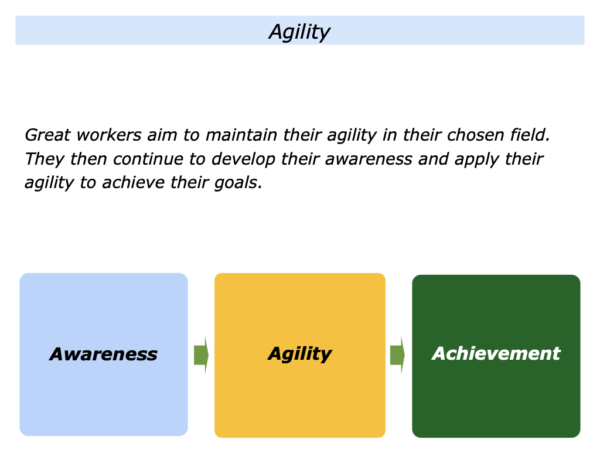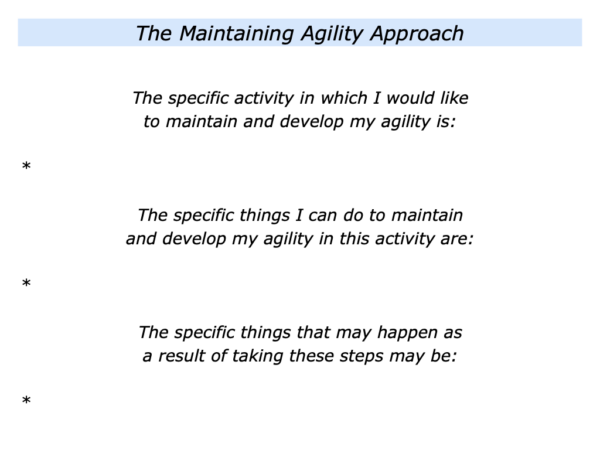
Great workers aim to maintain their agility in their chosen field. They do this by continuing to develop their awareness and applying their agility to achieve their goals.
Such workers aim to maintain their personal, psychological or professional agility. Taking this approach enables them to continue to feel alive and creative. This can help them to grow as people and as professionals.
Imagine that you want to follow this approach in your own way. This sometimes involves focusing on the following themes.
Awareness
Great workers keep developing awareness in their chosen field. Some do this by focusing on their personal, professional and patterns awareness. Here is an introduction to these themes.
Personal Awareness
Such workers continue to develop their personal awareness. Some aim to be aware of: a) their personal goals; b) their strengths and weaknesses; c) their behaviour and the potential impact it may have on other people.
Professional Awareness
Some people aim to develop their professional awareness. They aim: a) to recognise future developments and challenges in their chosen field; d) to add to their professional knowledge and do what is required to thrive in their work.
Patterns Awareness
Pattern recognition is one of the keys to peak performance. Great workers are good at recognising both successful and unsuccessful patterns in their area of expertise. They then aim to build on the successful patterns and find ways to manage any unsuccessful patterns.
Such people often focus on their professional field. They aim to be aware of: a) what is happening; b) what could happen; c) what they would like to make happen. This can lead to the next theme.
Agility
Great workers continue to build their strengths. They then apply their personal, psychological or professional agility to be proactive and stay ahead of the game.
They use their agility – experience, knowledge and creativity – to explore the following questions.
What is actually happening? What may happen in the future? What may be the implications of these things happening – both for myself and for other people?
Bearing in mind what I can control, what do I want to do in the future? What are the goals – the real results I want to achieve? What may be the picture of success? What would be the benefits of achieving these goals?
What are the possible options going forwards? What are the consequences – the pluses and minuses – of each option? Are there any other potential creative options?
What is the route I want to follow? Bearing this in mind, what are the key strategies I can follow to increase the chances of success? How can I translate these into a clear action plan?
Such workers often rehearse the steps they are going to take. This includes using their agility to clarify how to prevent or manage certain challenges along the way. They leads to the next stage.
Achievement
Great workers move into action. They aim to be fully present, pursue their strategies and perform superb work. At the same time, they also keep reading reality.
They use their antennae to recognise what is happening. They then use their agility to respond by aiming: a) to build on what is working; b) to tackle areas for improvement.
Such workers have what is called personal radar in the areas where they excel. They have the ability to see patterns and predict what may happen. They then reach into their repertoire of skills and apply these to achieve the desired results.
There are many ways to do fine work. One approach is to keep maintaining your personal, psychological or professional ability. This helps to keep you alive and creative.
Imagine you want to maintain your agility in a specific activity. How can you do this in your own way? If you wish, try tackling the exercise on this theme. This invites you to complete the following sentences.







Leave a Reply